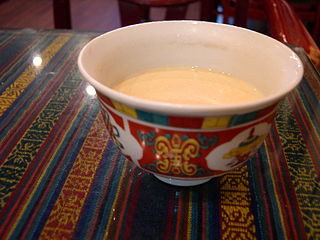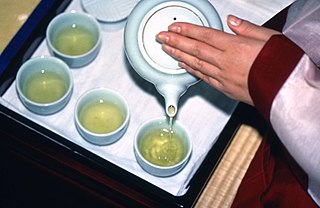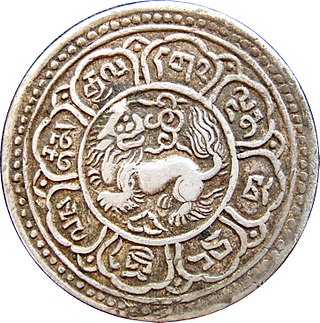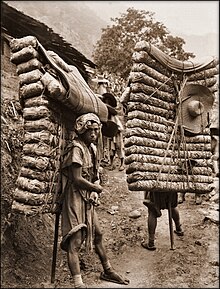
Tea, or cha, is an aromatic beverage prepared by pouring hot or boiling water over cured or fresh leaves of Camellia sinensis, an evergreen shrub native to East Asia which probably originated in the borderlands of southwestern China and northern Myanmar. Tea is also made, but rarely, from the leaves of Camellia taliensis. After plain water, tea is the most widely consumed drink in the world. There are many different types of tea; some have a cooling, slightly bitter, and astringent flavour, while others have profiles that include sweet, nutty, floral, or grassy notes. Tea has a stimulating effect in humans, primarily due to its caffeine content.

Green tea is a type of tea that is made from Camellia sinensis leaves and buds that have not undergone the same withering and oxidation process which is used to make oolong teas and black teas. Green tea originated in China, and since then its production and manufacture has spread to other countries in East Asia.

Pu'er or pu-erh is a variety of fermented tea traditionally produced in Yunnan Province, China. In the context of traditional Chinese tea production terminology, fermentation refers to microbial fermentation, and is typically applied after the tea leaves have been sufficiently dried and rolled. As the tea undergoes controlled microbial fermentation, it also continues to oxidize, which is also controlled, until the desired flavors are reached. This process produces tea known as hēichá (黑茶), literally "black tea", though the term is commonly translated to English as "dark tea" to distinguish it from the English-language black tea.

Tsampa or Tsamba is a Tibetan and Himalayan staple foodstuff, it is also prominent in parts of northern Nepal. It is glutinous meal made from roasted flour, usually barley flour and sometimes also wheat flour and flour prepared from tree peony seeds. It is usually mixed with the Tibetan butter tea. It is also eaten in Turkestan and Mongolia, where it is known as zamba.
The history of tea in China is long and complex, for the Chinese have enjoyed tea for millennia. Scholars hailed the brew as a cure for a variety of ailments; the nobility considered the consumption of good tea as a mark of their status, and the common people simply enjoyed its flavour. In 2016, the discovery of the earliest known physical evidence of tea from the mausoleum of Emperor Jing of Han in Xi'an was announced, indicating that tea from the genus Camellia was drunk by Han dynasty emperors as early as the 2nd century BCE. Tea then became a popular drink in the Tang (618–907) and Song (960–1279) dynasties.

Chinese tea generally refers to a variety of teas which are grown or consumed in China.

Ya'an is a prefecture-level city in the western part of Sichuan province, China, located just below the Tibetan Plateau. The city is home to Sichuan Agricultural University, the only 211 Project university and the largest regional comprehensive university in Ya'an. As of the 2020 Chinese census, Ya'an has a population of 1,434,603.

Tea culture is defined by how tea is made and consumed, how people interact with tea, and the aesthetics surrounding tea drinking.

Dianhong tea is a type of relatively high-end, gourmet Chinese red tea sometimes used in various tea blends and grown in Yunnan Province, China. The main difference between Dianhong and other Chinese red teas is the amount of fine leaf buds, or "golden tips," present in the dried tea. Dianhong tea produces a brew that is brassy golden orange in colour with a sweet, gentle aroma and no astringency. Cheaper varieties of Dianhong produce a darker brownish brew that can be very bitter.

Tibet developed a distinct culture due to its geographic and climatic conditions. While influenced by neighboring cultures from China, India, and Nepal, the Himalayan region's remoteness and inaccessibility have preserved distinct local influences, and stimulated the development of its distinct culture.

Butter tea, also known as Bho jha, cha süma, is a drink of the people of Tibet and western regions of modern-day China. Traditionally, it is made from tea leaves, yak butter, water, and salt, although butter made from cow's milk is increasingly used, given its wider availability and lower cost.

The history of tea in Japan began as early as the 8th century, when the first known references were made in Japanese records. Tea became a drink of the religious classes in Japan when Japanese priests and envoys sent to China to learn about its culture brought tea to Japan. The Buddhist monks Kūkai and Saichō may have been the first to bring tea seeds to Japan. The first form of tea brought from China was probably brick tea. Tea became a drink of the royal classes when Emperor Saga encouraged the growth of tea plants. Seeds were imported from China, and cultivation in Japan began.

Tibetan cuisine includes the culinary traditions and practices of the Tibetan people in the Tibet region. The cuisine reflects the Tibetan landscape of mountains and plateaus and includes influences from neighbors. It is known for its use of noodles, goat, yak, mutton, dumplings, cheese, butter, yogurt, and soups. Vegetarianism has been debated by religious practitioners since the 11th century but is not prevalent due to the difficulty of growing vegetables, and cultural traditions promoting consumption of meat.

Korean tea is a beverage consisting of boiled water infused with leaves, roots, flowers, fruits, grains, edible mushrooms, or seaweed. It may or may not contain tea leaves.

Fermented tea is a class of tea that has undergone microbial fermentation, from several months to many years. The exposure of the tea leaves to humidity and oxygen during the process also causes endo-oxidation and exo-oxidation. The tea leaves and the liquor made from them become darker with oxidation. Thus, the various kinds of fermented teas produced across China are also referred to as dark tea, not be confused with black tea. The most famous fermented tea is pu'er produced in Yunnan province.

Tea processing is the method in which the leaves from the tea plant Camellia sinensis are transformed into the dried leaves for brewing tea.

The use of historical money in Tibet started in ancient times, when Tibet had no coined currency of its own. Bartering was common, gold was a medium of exchange, and shell money and stone beads were used for very small purchases. A few coins from other countries were also occasionally in use.
Tibetan tea is a post-fermented tea that originated in Yaan. It has been long been traded as a tea brick between China and Tibet. The tea is packed in Kangting and shipped over the caravan routes by yak.

Matcha (抹茶) ; is a finely ground powder of specially grown and processed green tea leaves that originated in China and developed in Japan. It is mostly produced in Japan today. In the 12th century at the latest, Chinese compressed tea, the raw material for matcha, was introduced to Japan. When the production of compressed tea was banned in China in 1391, matcha was abandoned in China and developed in Japan thereafter.
Doncha, also called jeoncha, is a coin-shaped post-fermented tea produced in Korea. The tea has been called cheongtae-jeon in the Jangheung region in South Jeolla Province.



















